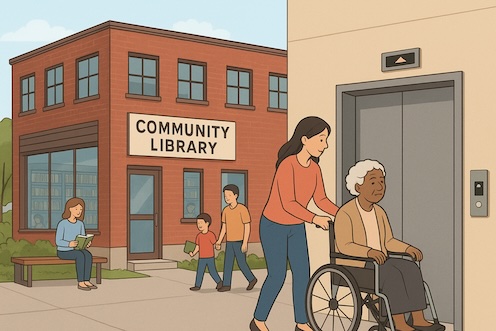In the old town area of a second tier city, a community library transformed from an old textile factory stands quietly. The three story red brick building houses a collection of 30000 books and hosts ten children's reading activities every Tuesday, with an average of 300 readers per day. It is known as the "spiritual living room" for residents. However, in the spring of 2022, Ms. Chen, the administrator, discovered that due to the lack of elevators, nearly 40% of readers gave up going to the second and third floors, including twelve wheelchair bound elderly people and many parents holding children. So, a debate about purchasing elevators for "vertical equality" began.

Hidden dangers buried by "goodwill": Public welfare spaces encounter elevator difficulties
Ms. Chen initially only wanted to find a "functional" elevator. She chose the lowest priced domestic non machine room elevator: 630kg load capacity, with a total price of 280000 yuan, which is 15% lower than the market average price.
Reality has been hit one after another: during construction, it was found that the thickness of the floor slab was insufficient, requiring reinforcement of 30000 yuan; After being put into use, it was ordered to shut down due to the balance coefficient not meeting the standard, and an additional 26000 yuan was spent on rectification; After restarting, there have been frequent incidents of "trapping people", even causing a 5-year-old child to cry.
Even more ironic is that the elevator certificate label applies to "low-frequency civil buildings", while the library's usage frequency is eight times higher. Ms. Chen applied for an upgrade service, but was rejected by the manufacturer on the grounds of "choosing an economy package".
Industry "Cracks" Revealed by Data: Triple Dilemma of Public Welfare Elevators
Public welfare organizations generally face:
Procurement mismatch: 76% chose low-priced elevators due to budget constraints, and 61% experienced major malfunctions within two years;
Standard ambiguity: 43% did not indicate the frequency of use and load range, resulting in "civilian elevators being used as commercial elevators";
Maintenance vacuum: 82% is managed by property management, but only 29% have qualifications, with an average fault response time of 6.8 hours.
In the library, a power outage caused three students to be trapped for 40 minutes. Parents posted on social media claiming that the public library had become a dangerous space, and the number of visitors dropped by 60% within a week.
Breakthrough Case: From "Survival Crisis" to "Community Benchmark"
The transfer occurred with the help of a retired elevator engineer:
Reconfigure: "High frequency commercial elevator" should be selected, with a design life of ≥ 20 years and daily operation of ≥ 200 times;
Add redundancy: Install dual braking system and car air circulation device;
Sign a full maintenance contract: Clearly state that 'the entire machine can be replaced if the failure rate is ≥ 5%'.
The elevator has been running stably for one year after the renovation. Ms. Chen also launched an "Elevator Open Day" to educate residents about the computer room and emergency operations, and transformed the control cabinet into a "Science Popularization Display Cabinet". The event unexpectedly became popular on the internet, with over 5 million views of related videos. The word "dangerous" was replaced by "warm", and the daily flow of people returned to 280. The second floor "Silver Hair Book Corner" even requires appointments.
The ultimate proposition of public welfare elevators: from "cost game" to "value synergy"
Ms. Chen's experience reveals that elevators in public welfare places are not just means of transportation, but a measure of social equity. The market urgently needs to answer three major questions:
Can we build standards like a school? Develop specialized standards for public welfare facilities (load fluctuation range, seismic design, emergency power supply, etc.);
Can it be managed like firefighting? Establish a government subsidy maintenance system to ensure response within 30 minutes;
Can it be made public like a bill? Utilize the Internet of Things to publicly disclose real-time operational data, making every public welfare fund transparent and traceable.
If you would like to obtain a more detailed solution, please contact us.
